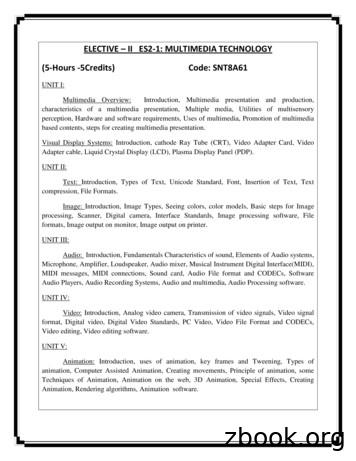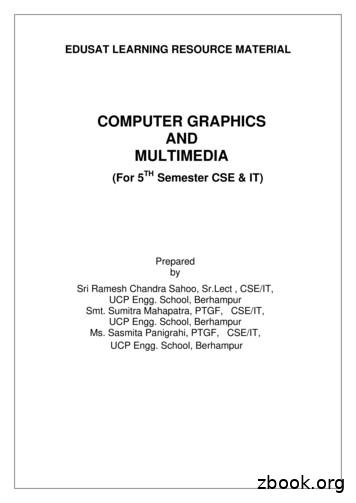Multimedia Applications User Requirements
COMP 249 Advanced Distributed SystemsMultimedia NetworkingMultimedia Applications&User RequirementsKevin JeffayDepartment of Computer ScienceUniversity of North Carolina at Chapel Hilljeffay@cs.unc.eduAugust 24, 1999http://www.cs.unc.edu/ jeffay/courses/comp249f991Course OutlineIntroduction to multimedia!Distributed multimedia applications» What are they and why do we want them?» User and application requirements!Audio and video as a data type» Audio & video coding and compression technologies» Audio/Video “protocols”2
Distributed Multimedia ApplicationsExamples!Entertainment» Video-on-demand» Multi-player games!Collaborative work» Remote consultation!Distance learning» Interactive television» Content-on-demand!Communication» Internet telephony & videoconferencing3Interactive Multimedia ApplicationsWhy do we want them?!Who wouldn’t love videoconferencing?» Reduces the need for travel» Reduces the need for physical proximity of co-workers!Surely it’s better than a phone call?» Enhances audio communication with non-verbal cues» Contributes to team and consensus building» Enables remote demonstrations and “show and tells”4
Interactive Multimedia ApplicationsWhy do we want them?!Numerous user studies have found:» Groups are neither more effective nor efficient atproblem solving when using videoconferencing thanwhen using the telephone!Numerous commercial products have either failedor at best not succeeded»»»»AT&T PicturephoneIntel ProShare systemIBM Person-to-Person system.5Interactive Multimedia ApplicationsThe Picturephone debacle!!A product of AT&T from 1964-1978Excellent quality» 5.5 x 5 inch, black and white picture» 250 scan lines (TV quality)» 30 frames/s (perfect motion perception)!Use» Used handset or speakerphone for audio» Display could show either local or remote user!Cost» 75/month» 0.15/minute (first 30 minutes free)6
The Picturephone DebacleThe marketing guys said.!By 1975:50,000 units» Deployed in 25 cities!By 1980: 1,000,000 units» In 3% of all businesses and 1% of all homes!By 1985: 2,000,000 sident,196919697The Picturephone debacleDo we really want video-phones?!Public picturephone booths were deployed in NewYork, Chicago, and Washington DC (1964-1970)» 3 calls were placed in 1969» 0 calls in 1970!Local picturephone service deployed in Chicago& Pittsburgh (1971-1977)» less than 100 users in Chicago in 1973» 9 users in 1977!Specialized test markets & free promotions» public room teleconferencing» numerous large corporations» hospitalsall failed to create a market8
The Picturephone debacleWhat went wrong?!No compelling uses of the technology!Lack of inertia — need other picturephones to talk to!Users didn’t like it» People were too uncomfortable & self-conscience on camera» It didn’t “add enough” to audio-only communications» Wasn’t close enough to face-to-face communication9The Picturephone debacleWould the situation be different on the Internet today?!!Are the applications for this technology here?Is the inertia problem any better?» Much better for simple Internet telephony!Will post-MTV generation users accept video more today?» Not likely — non-verbal cues still missing or wrong no eye contactwhen eye contact exists, it’s not directed to any one participantinflexible proximity & orientationand wrong cues are harder to compensate for than missing cues!!And Internet multimedia applications are not likely toperform well!10
Interactive Multimedia ApplicationsCan interactive audio and video provide any benefits?!They do not yet impact the product but they canimpact the process» Video helps management of the mechanics of conversation» Potentially makes more efficient use of the time spentcommunicating!But these benefits are realized only if criticalperformance criteria are met:»»»»ThroughputEnd-to-end latencyDelay-jitterLoss11Interactive Multimedia ApplicationsPerformance requirements!Latency — the duration between acquisition of a signaland its display!Videoconferencing latency requirements» telephony literature — 100 ms roundtrip» multimedia networking literature — 250 ms one-way» CSCW literature — tolerance of latency as high as 400 ms12
Latency in Computer-Based Video SystemsCanonical application itCompress336610013Latency in Computer-Based Video SystemsCanonical application sst 33Displayt 66t 10014
Latency in Computer-Based Video SystemsReceiver synchronizationMedia generation pointsSenderReceiverDisplay initiation points!In general, acquisition and display clocks are notsynchronized.!Therefore a buffer must be present at the receiver to adjustfor phase-shift in sender’s & receiver’s media clocks» Greatest lower bound on buffer residency is 33 – ε ms15Latency in Computer-Based Video SystemsBest case end-to-end latencyDigitizeTime(ms)0Compress33Sender ProcessingTransmit/ iver Processing16
Latency in Computer-Based Video SystemsBest case end-to-end latency (hypothetical)Frame 2Frame 1Frame 3Frame 4SenderReceiverTime(ms)!013326631004133Assuming » Compression/decompresssion times go to 0 » Displays with high-refresh rates.» “Early” transmission of digitized scan ynchronizationtransmission delaydelayGLBdelaydelay 16 ms x ms 33 ms 16 ms17Latency in Computer-Based Audio SystemsHow bad can audio latency be?!Just as bad as video if lip-synchronization is required» (More on this later )!Otherwise, it depends on how one manages thenetwork interface» Video frames are typically too large to fit into a singlenetwork packet» Multiple audio samples can be transmitted together hencetransmission buffering at the sender effects latency18
Latency in Computer-Based Audio SystemsSender buffering & packaging example!Consider an audio codec generating 1 byte samplesof data every 125 µs» Transmit 1 sample per packet(No additional latency introduced at the sender)Sender0 0.5 1.0 1.5 2.0 2.5 3.0 3.5 4.0 4.5 5.0 5.5 6.0 6.5 7.0 7.5 8.0Receiver0 0.5 1.0 1.5 2.0 2.5 3.0 3.5 4.0 4.5 5.0 5.5 6.0 6.5 7.0 7.5 8.0Latency19Latency in Computer-Based Audio SystemsSender buffering & packaging example!Consider an audio codec generating 1 byte samplesof data every 125 µs» Transmit 20 samples per packet20 byte packetSender0 0.5 1.0 1.5 2.0 2.5 3.0 3.5 4.0 4.5 5.0 5.5 6.0 6.5 7.0 7.5 8.0Receiver0 0.5 1.0 1.5 2.0 2.5 3.0 3.5 4.0 4.5 5.0 5.5 6.0 6.5 7.0 7.5 8.0latency buffering/packagingtransmissionsynchronization delaydelaydelay20
Latency in Computer-Based Audio SystemsSender buffering & packaging!Consider an audio codec generating 1 byte samplesof data every 125 µs!More realistic examples» Building 500 byte packets requires 62.5 ms» Building 1,500 byte packets requires 187.5 ms!A canonical Internet audio packet typically contains20-30 ms worth of audio data» The actual size of the packet depends on the coding/compressionscheme employed21Performance RequirementsDelay-jitter!Latency» 250 ms one-way!Delay-jitter — Variation in end-to-end 22
Performance requirementsThe impact of delay-jitter!Delay-jitter leads to “gaps” in the playout ofmedia and increases playout latencySenderReceiverDisplay initiation pointsPlayout gaps23Performance requirementsThe impact of delay-jitter!Delay-jitter increases playout latencylatency platency 3pSenderReceiverDisplay initiation pointsPlayout gaps24
Performance RequirementsThroughput and loss!Latency» 250 ms one-way!Delay-jitter!Throughput —the effective delivered frame orsample rate» For video the issue is motion perception» For audio the issue is comprehensionthroughput requirements are a (complex) functionof coding and compression schemes!Loss — the complement of throughput25Performance requirementsLoss!Loss has the same effect as delay-jitter: playout gaps» With a potentially beneficial effect of potentially lower latencylatency platency 3platency 2pSenderXReceiverDelay-jitter inducedplayout gapsLoss inducedplayout gap26
Avoiding Loss in the End SystemReal-time management of a processing pipelineDigitizeTransmit/Compress Synchronize DecompressDisplayFrame nFrame n 1Frame n er’sPipeline27Performance requirementsLoss requirements!Audio — 1-2% sample loss» individual sample losses (depending on sample size) arenoticeable» 5-10 lost samples per minute are tolerable(the distribution of loss and size of sample are criticalparameters)!Video — 10-15 frames/s required for minimalmotion perception» highly application dependent» video loss raise issues of “network citizenship”28
Performance RequirementsLip synchronization!Latency» 250 ms one-way!!Delay-jitterThroughput —the effective delivered frame orsample rate» For video the issue is motion perception» For audio the issue is comprehension!Loss!Lip synchronization» The temporal relationship between an audio and videostream representing a human speaking29Performance RequirementsLip synchronization!Perfect lip synchronization requires audio playoutfor sample 1 at timeVideoProcessingDigitizeAudioProcessing 1 2 3 4 5 t66Decompress100133Display16730
Performance RequirementsLip synchronization!Varying lip sync can be an effective technique inmitigating high video o1 2 3 4 5 6Processing 1 2 3 4 5 6acquisition/ Transmit splay167But. this is fundamentally unnatural!31Interactive Multimedia ApplicationsPerformance requirementsInternet!!!!No more than 250 ms end-to-end, one-way latencyContinuous audioMinimum of 10 frames per second video throughput“Loosely synchronized” playout — 80 ms skew32
Multimedia Applications & the InternetSummary!The case for pervasive deployment of distributed,interactive, multimedia applications has yet to be made!The Internet is inherently ill-suited to meeting the realtime requirements of real-time multimedia applications» The problems are accidental!But there’s cool technology and science to be studied!33
Multimedia Applications & the Internet Summary! The case for pervasive deployment of distributed, interactive, multimedia applications has yet to be made! The Internet is inherently ill-suited to meeting the real-time requirements of real-time multimedia applications » The problems are accidental! But there’s cool technology and science to .
Introduction to Multimedia (continued) Multimedia becomes interactive multimedia when a user is given the option of controlling the elements. Interactive multimedia is called hypermedia when a user is provided a structure of linked elements for navigation. Multimedia developers develop multimedia projects.
Learn the phases involved in multimedia planning, design and production; Be able to use various multimedia authoring tools Be able to design and create interactive multimedia products Develop competencies in designing and producing instruction-al multimedia Apply contemporary theories of multimedia learning to the development of multimedia .
MULTIMEDIA V.S MULTIMEDIA INTERAKTIF Multimedia adalah penggunaan berbagai jenis media (teks, suara,grafik,animasi,danvideo). Multimedia interaktif menambahkan elemen ke-enam yaitu aspek interaktif Pada multimedia non-interaktif, user bertindak pasif dan menyaksikan adegan demi adegan secara berurut
MULTIMEDIA TECHNOLOGY UNIT – I Multimedia an overview: Introduction The word ‗multimedia‘ comes from the Latin words multus which means ‗numerous‘ and media which means ‗middle‘ or center. Multimedia therefore means ‗multiple intermediaries‘ or ‗multiple means‘. Multimedia
multimedia contexts and for converting one file format to another. Multimedia Editing Tools- These tools are used for creating and editing digital multimedia data. Multimedia Authoring Tools- These tools are used for combing different kinds of media formats and deliver them as multimedia contents. Graphic and Image Editing Software
Multimedia Systems; Buford; Pearson 3. Multimedia: Sound and Video by Jose Lozano, PHI 4. Multimedia Systems,Tech. & Communications; S.Pandey, M.Pandey; Katson. Chapter 1 Applications of Computer Graphics & Multimedia Copy Right DTE&T,Odisha Page 1 1. Applications of Computer Graphics & Multimedia
applications. Multimedia applications are highly delay sensitive. We will see shortly that packets that incur a sender-to-receiver delay of more than a few hundred milliseconds (for Internet telephony) to a few seconds (for streaming of stored multimedia) are essentially useless. On the other hand, multimedia networking applications are also .
BCS Foundation Certificate in Artificial Intelligence V1.1 Oct 2020 Syllabus Learning Objectives 1. Ethical and Sustainable Human and Artificial Intelligence (20%) Candidates will be able to: 1.1. Recall the general definition of Human and Artificial Intelligence (AI). 1.1.1. Describe the concept of intelligent agents. 1.1.2. Describe a modern .





















